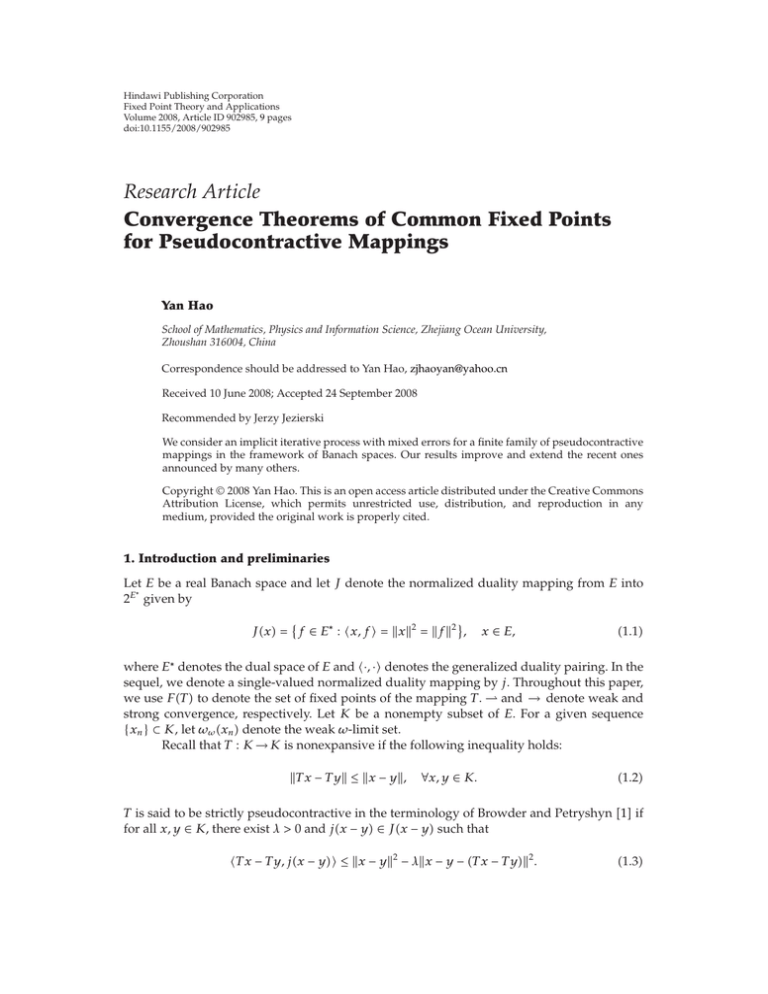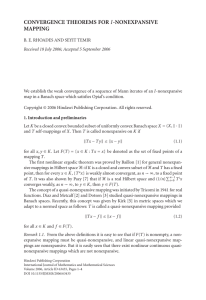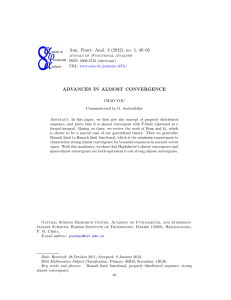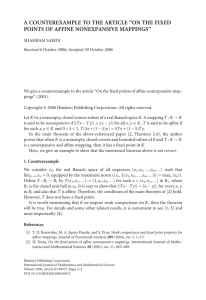Hindawi Publishing Corporation Fixed Point Theory and Applications pages
advertisement

Hindawi Publishing Corporation
Fixed Point Theory and Applications
Volume 2008, Article ID 902985, 9 pages
doi:10.1155/2008/902985
Research Article
Convergence Theorems of Common Fixed Points
for Pseudocontractive Mappings
Yan Hao
School of Mathematics, Physics and Information Science, Zhejiang Ocean University,
Zhoushan 316004, China
Correspondence should be addressed to Yan Hao, zjhaoyan@yahoo.cn
Received 10 June 2008; Accepted 24 September 2008
Recommended by Jerzy Jezierski
We consider an implicit iterative process with mixed errors for a finite family of pseudocontractive
mappings in the framework of Banach spaces. Our results improve and extend the recent ones
announced by many others.
Copyright q 2008 Yan Hao. This is an open access article distributed under the Creative Commons
Attribution License, which permits unrestricted use, distribution, and reproduction in any
medium, provided the original work is properly cited.
1. Introduction and preliminaries
Let E be a real Banach space and let J denote the normalized duality mapping from E into
∗
2E given by
Jx f ∈ E∗ : x, f x2 f2 ,
x ∈ E,
1.1
where E∗ denotes the dual space of E and ·, · denotes the generalized duality pairing. In the
sequel, we denote a single-valued normalized duality mapping by j. Throughout this paper,
we use FT to denote the set of fixed points of the mapping T . and → denote weak and
strong convergence, respectively. Let K be a nonempty subset of E. For a given sequence
{xn } ⊂ K, let ωω xn denote the weak ω-limit set.
Recall that T : K → K is nonexpansive if the following inequality holds:
T x − T y ≤ x − y,
∀x, y ∈ K.
1.2
T is said to be strictly pseudocontractive in the terminology of Browder and Petryshyn 1 if
for all x, y ∈ K, there exist λ > 0 and jx − y ∈ Jx − y such that
T x − T y, jx − y ≤ x − y2 − λx − y − T x − T y2 .
1.3
2
Fixed Point Theory and Applications
T is said to be pseudocontractive if for all x, y ∈ K, there exists jx − y ∈ Jx − y such that
1.4
T x − T y, jx − y ≤ x − y2 .
It is well known that 2 1.4 is equivalent to the following:
x − y ≤ x − y − sI − T x − I − T y,
∀s > 0.
1.5
Recently, concerning the convergence problems of an implicit or nonimplicit iterative
process to a common fixed point,a finite family of nonexpansive mappings and its extensions
in Hilbert spaces or Banach spaces have been considered by several authors see 1–18 for
more details.
In 2001, Xu and Ori 17 introduced the following implicit iteration process for a finite
family of nonexpansive mappings {T1 , T2 , . . . , TN } with {αn } a real sequence in 0, 1 and an
initial point x0 ∈ K:
x1 α1 x0 1 − α1 T1 x1 ,
x2 α2 x1 1 − α2 T2 x2 ,
···
xN αN xN−1 1 − αN TN xN ,
1.6
xN1 αN1 xN 1 − αN1 T1 xN1 ,
···
which can be written in the following compact form:
xn αn xn−1 1 − αn Tn xn ,
∀n ≥ 1,
1.7
where Tn TnmodN here the mod N takes values in {1, 2, . . . , N}.
Xu and Ori 17 proved weak convergence theorems of this iterative process to a
common fixed point of the finite family of nonexpansive mappings in a Hilbert space.
Chidume and Shahzad 3 improved Xu and Ori’s 17 results to some extent. They obtained
a strong convergence theorem for a finite family of nonexpansive mappings if one of
the mappings is semicompact. Osilike 8 improved the results of Xu and Ori 17 from
nonexpansive mappings to strict pseudocontractions in the framework of Hilbert spaces.
Recently, Chen et al. 7 obtained the following results in Banach spaces.
Theorem CSZ. Let E be a real q-uniformly smooth Banach space which is also uniformly convex
and satisfies Opial’s condition. Let K be a nonempty closed convex subset of E and Ti : K → K, i 1, 2, . . . , N be strictly pseudocontractive mapping in the terminology of Browder-Petryshyn such that
∅, and let {αn } be a real sequence satisfying the conditions:
F N
i1 FTi /
0 < a ≤ αn ≤ b < 1.
1.8
Yan Hao
3
Let x0 ∈ K and let {xn } be defined by 1.7, where Tn Tn mod N . Then {xn } weakly converges to a
common fixed point of the mappings {Ti }N
i1 .
Very recently, Zhou 18 still considered the iterative Algorithm 1.7 in the framework
of Banach spaces. Zhou 18 improved Theorem CSZ from strict pseudocontractions to
Lipschitzian pseudocontractions. To be more precise, he proved the following theorem.
Theorem Z. Let E be a real uniformly convex Banach space with a Fréchet differentiable norm. Let
K be a closed convex subset of E, and {Ti } be a finite family of Lipschitzian pseudocontractive self
∅. Let {xn } be defined by 1.7. If {αn } is chosen so that
mappings of K such that F ri1 FTi /
αn ∈ 0, 1 with lim sup αn < 1, then {xn } converges weakly to a common fixed point of the family
{Ti }ri1 .
In this paper, motivated and inspired by Chidume and Shahzad 3, Chen et al. 7,
Osilike 8, Qin et al. 10, Xu and Ori 17, and Zhou 18, we consider an implicit iteration
process with mixed errors for a finite family of pseudocontractive mappings. To be more
precise, we consider the following implicit iterative algorithm:
x0 ∈ K,
xn αn xn−1 βn Tn xn γn un ,
∀n ≥ 1,
1.9
where {αn }, {βn }, and {γn } are three sequences in 0, 1 such that αn βn γn 1 and {un } is
a bounded sequence in K.
We remark that, from the view of computation, the implicit iterative scheme 1.7 is
often impractical since, for each step, we must solve a nonlinear operator equation. Therefore,
one of the interesting and important problems in the theory of implicit iterative algorithm
is to consider the iterative algorithm with errors. That is an efficient iterative algorithm to
compute approximately fixed point of nonlinear mappings.
The purpose of this paper is to use a new analysis technique and establish weak
and strong convergence theorems of the implicit iteration process 1.9 for a finite family
of pseudocontractive mappings in Banach spaces. Our results improve and extend the
corresponding ones announced by many others.
Next, we will recall some well-known concepts and results.
1 A space E is said to satisfy Opial’s condition 9 if, for each sequence {xn } in E, the
convergence xn → x weakly implies that
lim supxn − x < lim supxn − y,
n→∞
n→∞
∀y ∈ E y /
x.
1.10
2 A mapping T : K → K is said to be demiclosed at the origin if, for each sequence
{xn } in K, the convergences xn → x0 weakly and T xn → 0 strongly imply that T x0 0.
3 A mapping T : K → K is semicompact if any sequence {xn } in K satisfying
limn → ∞ xn − T xn 0 has a convergent subsequence.
In order to prove our main results, we also need the following lemmas.
4
Fixed Point Theory and Applications
Lemma 1.1 see 16. Let {rn }, {sn }, and {tn } be three nonnegative sequences satisfying the
following condition:
rn1 ≤ 1 sn rn tn ,
If
∞
n1 sn
< ∞ and
∞
n1 tn
∀n ≥ 1.
1.11
< ∞, then limn → ∞ rn exists.
Lemma 1.2 see 2. Let E be a real uniformly convex Banach space whose norm is Fréchet
differentiable. Let K be a closed convex subset of E and {Tn } be a family of Lipschitzian self-mappings
r
on K such that ∞
n1 Ln − 1 < ∞ and F i1 FTi . For arbitrary x1 ∈ K, define xn1 Tn xn , for
all n ≥ 1. Then limn → ∞ xn , jp − q exists for all p, q ∈ F and, in particular, for all u, v ∈ ωω xn ,
and p, q ∈ F, u − v, jp − q 0.
Lemma 1.3 see 19. Let E be a uniformly convex Banach space, K be a nonempty closed convex
subset of E, and T : K → K be a pseudocontractive mapping. Then I − T is demiclosed at zero.
Lemma 1.4 see 15. Suppose that E is a uniformly convex Banach space and 0 < p ≤ tn ≤ q < 1,
for all n ∈ N. Suppose further that {xn } and {yn } are sequences of E such that
lim supxn ≤ r,
n→∞
lim supyn ≤ r,
n→∞
lim tn xn 1 − tn yn r
1.12
n→∞
hold for some r ≥ 0. Then limn → ∞ xn − yn 0.
2. Main results
Lemma 2.1. Let E be a uniformly convex Banach space and K a nonempty closed convex subset of
∅.
E. Let Ti be an Li -Lipschitz pseudocontractive mappings from K into itself with F N
i1 FTi /
Assume that the control sequences {αn }, {βn }, and {γn } satisfy the following conditions:
i αn βn γn 1;
ii ∞
n1 γn < ∞;
iii 0 ≤ a ≤ αn ≤ b < 1.
Let {xn } be defined by 1.9. Then
1 limn → ∞ xn − p exists, for all p ∈ F;
2 limn → ∞ xn − Tm xn 0, for all 1 ≤ m ≤ N.
Proof. Since F N
n1 FTi / ∅, for any given p ∈ F, we have
xn − p2 αn xn−1 βn Tn xn γn un − p, jxn − p
αn xn−1 − p, jxn − p βn Tn xn − p, jxn − p γn un − p, jxn − p
≤ αn xn−1 − pxn − p βn xn − p2 γn un − pxn − p.
2.1
Yan Hao
5
Simplifying the above inequality, we have
xn − p2 ≤
γn
αn
xn−1 − pxn − p un − pxn − p.
αn γn
αn γn
2.2
If xn − p 0, then the result is apparent. Letting xn − p > 0, we obtain
xn − p ≤
γn
αn
xn−1 − p un − p
αn γn
αn γn
2.3
≤ xn−1 − p γn M,
where M is an appropriate constant such that M ≥ supn≥1 {un −p/a}. Noticing the condition
ii and applying Lemma 1.1 to 2.3, we have limn → ∞ xn − p exists. Next, we assume that
lim xn − p d.
n→∞
2.4
On the other hand, from 1.5 and 1.9, we see
1 − αn
xn − p xn − p xn − Tn xn 2αn
1 − αn
xn − p αn xn−1 − Tn xn γn un − Tn xn 2αn
γn 1 − αn 1 − αn
xn − p xn−1 − Tn xn un − Tn xn 2
2αn
xn−1
1
2 xn − 2 αn xn−1 1 − αn Tn xn γn un − Tn xn γn
γn 1 − αn un − Tn xn un − Tn xn 2
2αn
1
γn
1
xn−1 − p xn − p un − Tn xn 2
2
2αn
1
γn
1
≤ xn−1 − p xn − p
2α un − Tn xn .
2
2
n
2.5
Noting that the conditions ii and iii and 2.4, we obtain
1
1
≥ d.
x
x
lim inf
−
p
−
p
n−1
n
n→∞
2
2
2.6
On the other hand, we have
1
1
1
1
lim sup
≤
lim
sup
x
x
x
x
−
p
−
p
−
p
−
p
≤ d.
n
n−1
n
2 n−1
2
2
2
n→∞
n→∞
2.7
6
Fixed Point Theory and Applications
Combining 2.6 with 2.7, we arrive at
1
1
xn−1 − p xn − p
lim
d.
n → ∞ 2
2
2.8
lim xn−1 − xn 0.
2.9
By using Lemma 1.4, we get
n→∞
That is,
lim xni − xn 0,
n→∞
∀i ∈ {1, 2, . . . , N}.
2.10
It follows from 1.9 that
xn−1 − Tn xn 1
xn − xn−1 − γn un − Tn xn 1 − αn
γn
1
xn − xn−1 un − Tn xn .
≤
1 − αn
1 − αn
2.11
From the conditions ii and iii, we obtain
lim xn−1 − Tn xn 0.
2.12
xn − Tn xn ≤ αn xn−1 − Tn xn γn un − Tn xn .
2.13
n→∞
On the other hand, we have
From the condition ii and 2.12, we see
lim xn − Tn xn 0.
2.14
xn − Tni xn ≤ 1 Lxn − xni xni − Tni xni ,
2.15
n→∞
For each 1 ≤ i ≤ N, we have
where L max{Li : 1 ≤ i ≤ N}. It follows from 2.10 and 2.14 that
lim xn − Tni xn 0.
n→∞
2.16
Yan Hao
7
Therefore, for each 1 ≤ m ≤ N, there exists some i ∈ {1, 2, . . . , N} such that n i m mod N.
It follows that
xn − Tm xn xn − Tni xn ,
2.17
which combines with 2.16 yields that
lim xn − Tm xn 0,
n→∞
∀m ∈ {1, 2, . . . , N}.
2.18
This completes the proof.
Next, we give two weak convergence theorems.
Theorem 2.2. Let E be a uniformly convex Banach space with a Fréchet differentiable norm and K a
nonempty closed convex subset of E. Let Ti be an Li -Lipschitz pseudocontractive mapping from K into
∅. If the control sequences {αn }, {βn }, and {γn } satisfy the followings
itself with F N
i1 FTi /
conditions:
i αn βn γn 1;
ii ∞
n1 γn < ∞;
iii 0 ≤ a ≤ αn ≤ b < 1,
then the sequence {xn } defined by 1.9 converges weakly to a common fixed point of {T1 , T2 , . . . , TN }.
Proof. From Lemma 1.3, we see that ωω xn ⊂ F. It follows from Lemma 1.2 that ωω xn is
singleton. Hence, {xn } converges weakly to a common fixed point of {T1 , T2 , . . . , TN }. This
completes the proof.
Remark 2.3. Theorem 2.2 includes Theorem 3.1 of Zhou 18 as a special case. If {γn } 0 for
all n ≥ 1, then Theorem 2.2 reduces to Theorem 3.1 of Zhou 18. It derives to mention that
the method in this paper is also different from Zhou’s 18.
Theorem 2.4. Let E be a uniformly convex Banach space satisfying Opial’s condition and K a
nonempty closed convex subset of E. Let Ti be an Li -Lipschitz pseudocontractive mapping from K into
∅. If the control sequences {αn }, {βn }, and {γn } satisfy the followings
itself with F N
i1 FTi /
conditions:
i αn βn γn 1;
ii ∞
n1 γn < ∞;
iii 0 ≤ a ≤ αn ≤ b < 1,
then the sequence {xn } defined by 1.9 converges weakly to a common fixed point of {T1 , T2 , . . . , TN }.
8
Fixed Point Theory and Applications
Proof. Since E is uniformly convex and {xn } is bounded, we see that there exists a
subsequence {xni } ⊂ {xn } such that {xni } converges weakly to a point x∗ ∈ K. It follows
from Lemma 1.3 and arbitrariness of m ∈ {1, 2, . . . , N} that x∗ ∈ F.
On the other hand, since the space E satisfies Opial’s condition, we can prove that the
sequence {xn } converges weakly to a common fixed point of {T1 , T2 , . . . , TN } by the standard
proof. This completes the proof.
Remark 2.5. Theorem 2.4 improves Theorem 2.6 of Chen et al. 7 in several respects.
a From q-uniformly smooth Banach spaces which both are uniformly convex and
satisfy Opial’s condition extend to uniformly convex Banach spaces which satisfy
the Opial’s condition.
b From strict pseudocontractions extend to Lipschitzian pseudocontractions.
c From view of computation, the iterative Algorithm 1.9 also can be viewed as an
improvement of its analogue in 7.
Now, we are in a position to state a strong convergence theorem.
Theorem 2.6. Let E be a uniformly convex Banach space and K a nonempty closed convex subset of
∅.
E. Let Ti be an Li -Lipschitz pseudocontractive mappings from K into itself with F N
i1 FTi /
Assume that the control sequences {αn }, {βn }, and {γn } satisfy the followings conditions:
i αn βn γn 1;
ii ∞
n1 γn < ∞;
iii 0 ≤ a ≤ αn ≤ b < 1.
Let the sequence {xn } be defined by 1.9. If one of the mappings {T1 , T2 , . . . , TN } is semicompact, then
{xn } converges strongly to a common fixed point of {T1 , T2 , . . . , TN }.
Proof. Without loss of generality, we can assume that T1 is semicompact. It follows from 2.18
that
lim xn − T1 xn 0.
n→∞
2.19
By the semicompactness of T1 , there exists a subsequence {xni } of {xn } such that xni → x∗ ∈ K
strongly. From 2.18, we have
lim xni − Tm xni x∗ − Tm x∗ 0,
ni → ∞
2.20
for all m 1, 2, . . . , N. This implies that x∗ ∈ F. From Lemma 2.1, we know that limn → ∞ xn −
p exists for each p ∈ F. That is, limn → ∞ xn − x∗ exists. From xni → x∗ , we have
lim xn − x∗ 0.
n→∞
This completes the proof of Theorem 2.6.
2.21
Yan Hao
9
References
1 F. E. Browder and W. V. Petryshyn, “Construction of fixed points of nonlinear mappings in Hilbert
space,” Journal of Mathematical Analysis and Applications, vol. 20, no. 2, pp. 197–228, 1967.
2 K.-K. Tan and H.-K. Xu, “The nonlinear ergodic theorem for asymptotically nonexpansive mappings
in Banach spaces,” Proceedings of the American Mathematical Society, vol. 114, no. 2, pp. 399–404, 1992.
3 C. E. Chidume and N. Shahzad, “Strong convergence of an implicit iteration process for a finite family
of nonexpansive mappings,” Nonlinear Analysis: Theory, Methods & Applications, vol. 62, no. 6, pp.
1149–1156, 2005.
4 Y. J. Cho and X. Qin, “Viscosity approximation methods for a family of m-accretive mappings in
reflexive Banach spaces,” Positivity, vol. 12, no. 3, pp. 483–494, 2008.
5 Y. J. Cho, S. M. Kang, and X. Qin, “Convergence theorems of fixed points for a finite family of
nonexpansive mappings in Banach spaces,” Fixed Point Theory and Applications, vol. 2008, Article ID
856145, 7 pages, 2008.
6 Y. J. Cho, X. Qin, M. Shang, and Y. Su, “Generalized nonlinear variational inclusions involving A, ηmonotone mappings in Hilbert spaces,” Fixed Point Theory and Applications, vol. 2007, Article ID 29653,
6 pages, 2007.
7 R. Chen, Y. Song, and H. Zhou, “Convergence theorems for implicit iteration process for a finite
family of continuous pseudocontractive mappings,” Journal of Mathematical Analysis and Applications,
vol. 314, no. 2, pp. 701–709, 2006.
8 M. O. Osilike, “Implicit iteration process for common fixed points of a finite family of strictly
pseudocontractive maps,” Journal of Mathematical Analysis and Applications, vol. 294, no. 1, pp. 73–81,
2004.
9 Z. Opial, “Weak convergence of the sequence of successive approximations for nonexpansive
mappings,” Bulletin of the American Mathematical Society, vol. 73, no. 4, pp. 591–597, 1967.
10 X. Qin, Y. Su, and M. Shang, “On the convergence of strictly pseudo-contractive mappings in Banach
spaces,” Journal of Prime Research in Mathematics, vol. 3, pp. 154–161, 2007.
11 X. Qin, Y. Su, and M. Shang, “On the convergence of implicit iteration process for a finite family of
k-strictly asymptotically pseudocontractive mappings,” Kochi Journal of Mathematics, vol. 3, pp. 67–76,
2008.
12 X. Qin and Y. Su, “Approximation of a zero point of accretive operator in Banach spaces,” Journal of
Mathematical Analysis and Applications, vol. 329, no. 1, pp. 415–424, 2007.
13 X. Qin and M. A. Noor, “General Wiener-Hopf equation technique for nonexpansive mappings and
general variational inequalities in Hilbert spaces,” Applied Mathematics and Computation, vol. 201, no.
1-2, pp. 716–722, 2008.
14 Y. Su and X. Qin, “Strong convergence theorems for asymptotically nonexpansive mappings and
asymptotically nonexpansive semigroups,” Fixed Point Theory and Applications, vol. 2006, Article ID
96215, 11 pages, 2006.
15 J. Schu, “Weak and strong convergence to fixed points of asymptotically nonexpansive mappings,”
Bulletin of the Australian Mathematical Society, vol. 43, no. 1, pp. 153–159, 1991.
16 K.-K. Tan and H.-K. Xu, “Approximating fixed points of nonexpansive mappings by the Ishikawa
iteration process,” Journal of Mathematical Analysis and Applications, vol. 178, no. 2, pp. 301–308, 1993.
17 H.-K. Xu and R. G. Ori, “An implicit iteration process for nonexpansive mappings,” Numerical
Functional Analysis and Optimization, vol. 22, no. 5-6, pp. 767–773, 2001.
18 H. Zhou, “Convergence theorems of common fixed points for a finite family of Lipschitz
pseudocontractions in Banach spaces,” Nonlinear Analysis: Theory, Methods & Applications, vol. 68, no.
10, pp. 2977–2983, 2008.
19 H. Zhou, “Convergence theorems of fixed points for Lipschitz pseudo-contractions in Hilbert spaces,”
Journal of Mathematical Analysis and Applications, vol. 343, no. 1, pp. 546–556, 2008.




